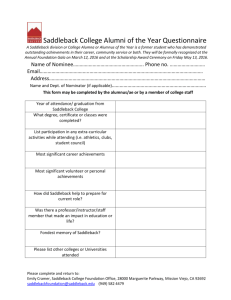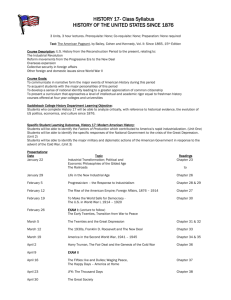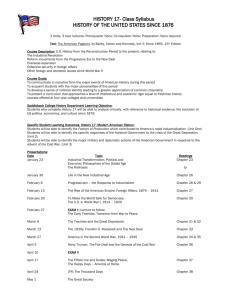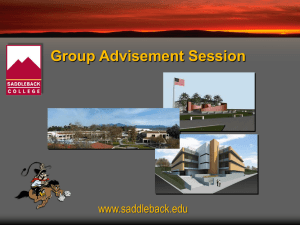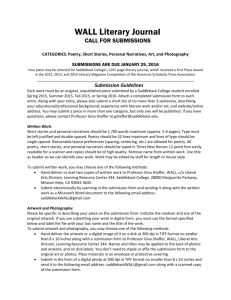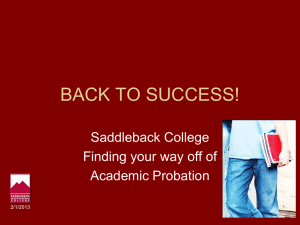read Kristopher`s paper
advertisement
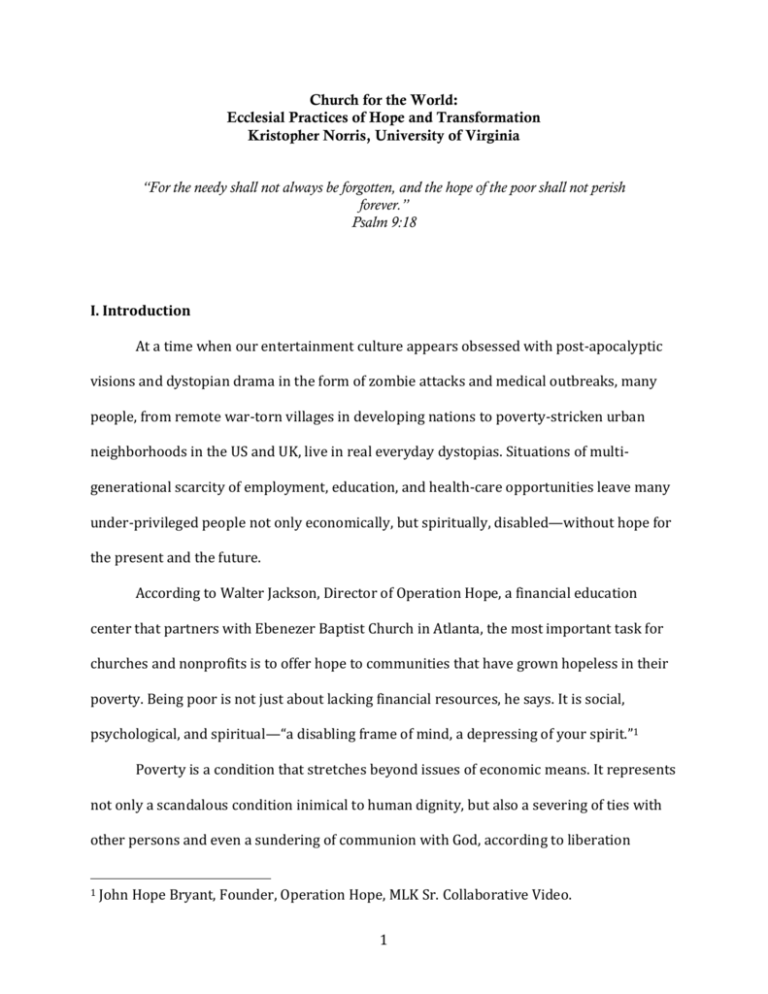
Church for the World: Ecclesial Practices of Hope and Transformation Kristopher Norris, University of Virginia “For the needy shall not always be forgotten, and the hope of the poor shall not perish forever.” Psalm 9:18 I. Introduction At a time when our entertainment culture appears obsessed with post-apocalyptic visions and dystopian drama in the form of zombie attacks and medical outbreaks, many people, from remote war-torn villages in developing nations to poverty-stricken urban neighborhoods in the US and UK, live in real everyday dystopias. Situations of multigenerational scarcity of employment, education, and health-care opportunities leave many under-privileged people not only economically, but spiritually, disabled—without hope for the present and the future. According to Walter Jackson, Director of Operation Hope, a financial education center that partners with Ebenezer Baptist Church in Atlanta, the most important task for churches and nonprofits is to offer hope to communities that have grown hopeless in their poverty. Being poor is not just about lacking financial resources, he says. It is social, psychological, and spiritual—“a disabling frame of mind, a depressing of your spirit.”1 Poverty is a condition that stretches beyond issues of economic means. It represents not only a scandalous condition inimical to human dignity, but also a severing of ties with other persons and even a sundering of communion with God, according to liberation 1 John Hope Bryant, Founder, Operation Hope, MLK Sr. Collaborative Video. 1 theologian, Gustavo Gutierrez.2 While the church must attend to the economic dimensions of poverty, he insists, it must also address the deeper and long-lasting implications. Being poor is all-encompassing; it is a “way of living, thinking, loving, praying, believing, and hoping, spending leisure time, and struggling for livelihood.” It is a condition, often wrapped up in other issues of marginalization like racism and sexism, which destroys families, individuals, and cultures.3 Taking a cue from Gutierrez, that the task of theology is an ecclesial function to reflect on Christian practice in light of the word of God, in this paper I attend to the specific practices of two Baptist congregations in confronting the scandal of poverty.4 I analyze the ways that these two vastly different Baptist congregations challenge the dystopian proclivities of our cultural malaise and dystopian realities faced by many in underresourced areas. These churches both offer 1) a unique and public vision of the church and its work toward human flourishing in the world and 2) concrete practices that seek to engage social, cultural, and political structures to provide hope and material resources to those who are oppressed or overlooked. Drawing from ethnographic research conducted at Saddleback Church, an Evangelical megachurch and Southern Baptist congregation in southern California, and Ebenezer Baptist Church, a Progressive National Baptist congregation and “home of Martin Gustavo Gutierrez, A Theology of Liberation (Maryknoll, NY: Orbis Books, 1988), 168. Gutierrez, xxi. 4 This summons also echoes the words of Friedrich Schleiermacher who noted that to exert any theological influence, one must appraise the actual condition of the church at that time. “The tasks of any person who is to exert influence of a genuinely deliberative character arise out of the way in which one appraises the actual condition of the church at the present time, according to one’s conception of the nature of both Christianity and of one’s own particular church community” (Schleiermacher, Brief Outline of Theology as a Field of Study, 97-98). 2 3 2 Luther King, Jr.” in Atlanta, Georgia, I will broadly outline the ecclesiological visions and socio-political practices of each church—focusing on one key mission effort of each church (the PEACE Plan at Saddleback and MLK Sr. Community Center at Ebenezer).5 I will argue that, despite their differences, both offer resources for concrete solutions to overcome these “hopeless” realities. They understand, in Jurgen Moltmann’s words, that hope is not only consolation in suffering, but protest against suffering; hope is never reconciled with the constraints of this earth: the inevitability of death nor evil that constantly bears more evil.6 Both churches draw on this eschatological vision of God’s promise and active work of redemption to inform two ostensibly divergent approaches to world engagement. They “answer dystopia” by offering hope—not an abstract sense of future promise, but tangible resources of hope amidst poverty to signal, in the words of Proverbs, “surely there is a future, and your hope will not be cut off” (23:18). II. Saddleback As we entered the large tent on the theme park-like campus of Saddleback Church, we were greeted by signs welcoming us to Global PEACE Night. The leader of a PEACE team, just returned from Rwanda, was addressing the problem of land grabbing to a crowd of several hundred. The Rwandan government refused to permit pastors to grant civil marriage licenses, and since most married couples did not have the resources to travel to a These church visits were part of a larger research project involving five congregations. Through ethnographic-style research, Sam Speers and I investigated the ways these churches understood themselves to be or not be political, and the ways their political practices helped them to integrate an inner/personal focus on faith development and evangelism with an outer/public focus on social justice. The project resulted in a coauthored book, Kingdom Politics: How Politics Can Help Solve What’s Wrong with Our Church (forthcoming, Cascade Books, 2014), from which some of this material is drawn. 6 Jugen Moltmann, Theology of Hope, (Minneapolis: Fortress Press, 1993), 21. 5 3 city court to obtain one, most marriages were never recognized by the state. When husbands died, widows often lost all of their property. The speaker explained that the Saddleback teams persuaded the government to change its policy and then trained local pastors on property rights, court proceedings, and the procedures for granting civil marriages. Saddleback then partnered with the Rwandan Ministry of Justice to ensure that the government continued pastor training in the villages in these areas on an ongoing basis. Another team member noted that this type of government and church partnership could not happen in the US. “The Rwandan government is not fettered by that [separation of church and state] prohibition,” she said. Last year the PEACE Team was called to testify before the US Congress on the effectiveness of its work in Rwanda. “We work to mobilize local churches and church members to address their own needs,” the leader continued. PEACE teams trained local church leaders in basic health care skills, creating mini-health clinics in villages across the country. They initiated a program to encourage local families in churches to adopt Rwandan children rather than sending them to US families.7 “Education, business and government have tried, but the local church is the answer to the healthcare problem,” the speaker concluded. As we left that night, we recalled some of Pastor Rick Warren’s words from the staff meeting we had attended earlier that day: “God’s antidote for the world is not politics. It’s the church.” My research partner and I came to Saddleback to interview church leaders and examine its approach to politics for a book project. While Saddleback, and its famous pastor 7 Brandon Lyons interview. 4 Rick Warren, avoids all talk of politics during the 14 worship services they hold every weekend, Saddleback’s PEACE Plan—the missional arm of the church—offers a different story. It entails, and is motivated by, deep political themes and practices. For years Saddleback’s ministry has pivoted around the “Purpose Driven” concept— the idea that scripture prescribes five universal purposes for every church and individual (worship, fellowship, discipleship, ministry, mission). And while this still animates much of what Saddleback does, the PEACE Plan is the next step, the “missions strategy of the Purpose model.”8 In a sense, the Purpose Driven idea has been “re-purposed” and expanded into a missions effort of global proportions. Most every problem in the world, Warren surmised after a trip to South Africa in 2003, can be traced back to one of five global “Giant Problems”: 1) Spiritual Emptiness, 2) Corrupt Leadership (including national, business, and home leadership), 3) Extreme Poverty, 4) Pandemic Disease, and 5) Rampant Illiteracy. In response, Warren began casting a new missional vision for the church, “so that the whole church cares about the whole gospel in a whole new way—through the local church."9 Witnessing firsthand the immense material need, not only in South Africa, but lingering silently amidst the affluence of Orange County, Warren acknowledged both the “responsibility of influence” of a church as large as Saddleback and the “responsibility of affluence” of one with so many resources. David Chrzan interview. During a trip to South Africa in 2003, Rick Warren became acutely aware of the magnitude of global need. The Body of Christ had become primarily a mouth, he observed. It is a Body that is now in need of reattaching its hands and feet. "I found those 2,000 verses on the poor,” he recalls, recounting his experience one night during his trip. “How did I miss God's compassion for the poor? I was not seeing all the purposes of God.” After meeting local pastors in South Africa, he prayed, "God, what are the other problems that you want to tackle? What are the problems so big that no one can solve them?" (Timothy C. Morgan, “Purpose Driven in Rwanda,” The Christian Century, September 2005, 34). 8 9 5 Warren understood it to be Saddleback’s task to “to lead the church worldwide to a more focused and effective expression of Jesus’ love, forgiveness, and hope.”10 A year later he launched the PEACE Plan, an attempt to mobilize Saddleback’s resources to address the world’s problems with five clear points of action, corresponding to the five global “Giants” (and, conveniently, the letters of the word PEACE): 1) Promoting Reconciliation (which replaced ‘Planting Churches’ a few years ago when Warren decided to focus more on partnerships with existing local churches), 2) Equipping Servant Leaders, 3) Assisting the Poor, 4) Caring for the Sick, and 5) Educating the Next Generation. It consists of many diverse initiatives, including new “outpost” churches in key cities, orphan care, recovery programs, relief work, poverty and hunger initiatives, English classes, healthcare training, HIV/AIDS prevention and treatment, sports programs, and clean water initiatives.11 According to the vision statement, “The PEACE Plan is the catalyst in bringing together a collaborative network of hundreds of thousands of churches and millions of Christians who take the lead in addressing the world’s five giant problems,” in the hopes of making an “eternal impact” on the world.12 Such a massive effort necessitates the involvement of a large percentage of church members. In a church the size of Saddleback, we were surprised to find a rather egalitarian, ground-up approach to ministry. Most of the church’s ministry and mission ideas are conceived and carried out by members themselves. We had imagined that a church this size would require more centralized control over its ministries and did not expect to find such a grassroots ethos in a congregation that seemed so concerned with quality and excellence in “The PEACE Plan” Brochure. Lyons interview. 12 “The PEACE Plan” Brochure. 10 11 6 production. Missions at Saddleback, one leader told us, often feels like “building airplanes in the air,” constantly tweaking, trashing, and starting over. “We learn, try, do, make mistakes.”13 According to church leaders, the bold scope of Saddleback’s missions agenda actually compels congregational involvement. “We are giving away the ministry to our people,” David Chrzan, Warren’s Chief of Staff, told us, which is how Saddleback operates a 30,000 member church with just 300 staff. Saddleback’s vision is perhaps more accurately a “missionhood of all believers.” As one pastor noted, “We firmly believe there is no distinction between staff and volunteers.” The members are the ministers and staff the administers. This is consistent with its low-church Baptist tradition—Saddleback is a Southern Baptist congregation after all (though this is an affiliation it “wears lightly”). But beyond this surprising degree of congregational buy-in, the most recurrent and salient theme in all of our discussions with Saddleback pastors about the PEACE Plan was their confidence in the local church as the vehicle for world change. The church’s printed guides to the PEACE plan explain that “there is no organization or government that can effectively address these giant problems. . . . The church has the world’s largest distribution network, the most people ready and willing to serve, and the greatest motivation of all— the love and compassion of Jesus Christ.”14 Government is not the answer, Mike Constanz, the Global PEACE Pastor, reiterated. The local church is the answer. The church needs a holistic faith and approach to the Christian life, one that understands social needs as integral to the church’s mission—not something the church leaves up to others to do with less effectiveness. By mobilizing local churches across the 13 14 Mike Constanz interview. “The PEACE Plan” brochure, and Bill Mugford interview. 7 globe, the church can reach people and their needs more effectively. PEACE leader Brandon Lyons told us, “We’ve given the UN their shot. We’ve given education its shot.” But the church has over two billion members, he said. “Throughout human history there’s only one thing that solves it, and that’s the church. There are not enough doctors to cure all the diseases in the world. But if we can train the local church to do it, there’s a massive amount of churches in the world. The church can do it.” According to church leaders, this ecclesio-centric focus pivots on the church’s ability to fight poverty in a more effective manner. “The church is the institution with the resources to solve the world’s problems,” David Chrzan put it bluntly. “The church can eradicate global poverty.” David noted that just one hundred years ago, the church ran half of all social institutions; now, he lamented, it has “abdicated” its social ministry and responsibility to the government. According to David, the problem began when the fundamentalists started over-emphasizing personal piety and the mainliners “became society clubs,” leaving this work to non-church institutions and leaving the church without a social vision. “You have to bring those things back together!” he said, “and ask, ‘What can we do that only the church can do?’” But what motivates this ecclesio-centric model? This distrust in government programs is in some ways motivated by typical southern California conservative partisanship—“Do you want more government in your life?” David asked us rhetorically. But even more, it seems a commitment to effectiveness plays the largest role. “We will come up with a sustainable solution so that government won’t have to,” David concluded. Nearly every decision in the church seems to pivot on the criterion of its effectiveness. Warren begins the Purpose process with the questions: “Are we doing what God intends for us to 8 do?” and “How well are we doing it?” David noted that the Purposes are evaluated in terms of measurable results and not just activities. The church is supposed to operate efficiently—and Saddleback does. Because it operates with less bureaucracy than the government, it can do things the government will never be capable of doing, leaders insist. For Brandon Lyons, this motivation exceeds mere effectiveness; the church is the only institution called by God to accomplish this work. Not only can other organizations not do this as effectively, he said, “We’re the only ones with the moral authority to do it.” All of this is by God’s design, leaders insist: God’s wisdom will be made manifest in the world through the church (Ephesians 3:10). III. Ebenezer Ushers clad in white gloves and black dresses and suits escorted us to our seats whole the small orchestra played enthusiastically. Dancers, wearing white gowns and carrying white banners, surrounded the altar. The energy in the congregation grew steadily through the Sunday morning worship service, and by the time the musical guest had finished singing—“At the midnight cry, when Jesus comes again, we’ll be going home!”—the congregation was on its feet, applauding ecstatically. Pastor Warnock delivered a sermon on letting go of your personal “baggage” and not hiding behind it like King Saul (Samuel 10:17-24). Far from the overtly political message we had anticipated, this sermon sounded strangely similar to the personal, therapeutic themes we heard during the worship experiences at Saddleback. Ebenezer Baptist Church in the Sweet Auburn neighborhood of Atlanta is the historic church home of Martin Luther King Jr. Established during Reconstruction by ex- 9 slaves as one of the only local public institutions for blacks, “America’s Freedom Church” boasts a deep history of involvement in the civil rights movement, a legacy that continues today in many forms of political action. The church engages politically on behalf of its lowincome neighborhood from “community outreach” programs like free haircuts and a clothing closet to more direct political action like voter registration and inviting political leaders like then-candidate Barack Obama to its pulpit. All of these efforts emanate from its commitment to worship and the mandate of Luke 4, church leaders say, to follow Jesus in proclaiming good news to the poor (4:18). Following the crescendoing worship experience, we met Dawn Brown, the Collaborative Director to show us around the new Martin Luther King, Sr. Community Resources Complex, adjacent to the sanctuary. Completed in the fall of 2012 the Complex houses the MLK Sr. Collaborative, a consortium of non-profits partnering with Ebenezer to provide community resources—the church’s newest and most expansive missional effort. With offices in the MLK Center, these community partners offer services directly to local families through the sponsorship and coordination of the church. Partners range from Catholic Charities to secular agencies like Operation Hope financial planners to government agencies like the State Department of Child and Family Services. Each partnering agency is part of what Ebenezer calls an “Integrated Service Delivery” model for community engagement. In this model, the partners work in tandem to provide all the services a local family needs. The model empowers families to make their own decisions about the care they receive. The idea to enable families to say, “This is what we want. These are services we think we need, and we want you to help us get to that 10 point.” Dawn and her team talk with each family about its goals in order to help it move toward self-sufficiency, home ownership, and constant employment with insurance, and will also discuss potential obstacles. “We want our services to reflect what the community is asking for.”15 Listening to the neighborhood and allowing its voices to determine the services provided by the Collaborative is an integral part of this model. The first step for church leaders was to determine whether there was a need for a collaborative resource center, or whether the church could meet community needs on its own by providing a referral service. Ebenezer initiated a series of meetings and surveys to assess community needs over a period of three years, talking with the people in need of services, as well as community “stakeholders” like city councilors and employers through “town hall” and neighborhood association meetings. In a community lacking hope, Ebenezer leaders determined that it was important to involve the local neighborhood in seeking solutions to its own the material problems. Partnering, not only with outside groups, but also with the very people one is trying to help, offers these partners not simply a handout but a purchase on hope. When the idea for a more centralized missions program emerged a few years ago, Ebenezer pastor Raphael Warnock concluded that the neighborhood’s needs were too large and complex for the church to handle on its own; they needed other organizations to locate in the neighborhood permanently. Ebenezer knew that it needed partners, and Warnock 15 Dawn Brown interview. 11 wanted to find outside organizations “who could see themselves in this vision,” both to help fund the building and to contribute a greater scope of services.16 Most of the services here “bend towards social transformation,” Warnock said. Citing Latin American liberation theologians who work alongside the poor, he laments the fact that churches are comfortable running soup kitchens, but often uncomfortable asking the deeper question, “Why are people poor in the first place?” They often avoid confronting systemic inequality and raising issues of public policy. “That’s where politics comes in,” he said. “We do it all. If we can move the average credit score in this neighborhood by 100 points, that will achieve something a march will never achieve. It’s got to be both-and, all of the above.” All of the church’s ministers told us there was no reluctance at Ebenezer to working with government groups or officials—“the gospel is political,” they say—and most often cited pragmatic reasons for partnering. “We recognize that we can’t do it all by ourselves so we partner with these other groups that are doing it at a much larger level than we can,” Associate Pastor Shanan Jones told us. The church was using $70,000 out of its operating funds every year to meet people’s emergency needs. This was simply unsustainable, and the needs in the neighborhood were growing. This community center provided a way to meet needs beyond what they could do alone. Partnering allows them to have a greater impact; “two cords are stronger than one,” Warnock quoted. The partners benefit from the legacy of the church and its existing networks, and the church benefits from the expertise the partners provide. 16 Walter Jackson interview. 12 “The collaborative gives us an opportunity to increase our capacity to be a servant church in ways that we would not be able to do if we were depending solely on our own resources,” Warnock explained. This denotes an intentional blurring of any division between sacred and secular. Warnock’s message to his congregation is always one of living missionally and collaborating with anyone with similar goals, even if they are not Christian. The only thing lost in partnering, he says, is the ability to proselytize. But this would not be the primary focus even if the church was doing these things all on its own, he said: “We seek to bear witness through service.” Through its MLK Sr. Center, Ebenezer offers a counter to the more church-centric rhetoric we heard at Saddleback. They identified the ways that context matters in a church’s missional focus: some churches have the means to engage in socially transformative activities on their own, and can envision themselves changing the world without reliance on non-church groups. “Based on our social location,” one staff-member explained, “we see that churches do not have the resources or funds to engage in the types of projects that Saddleback insists churches can do. We recognize that our role is to hold government and other agencies more accountable, so that people in our pews and neighborhood can get the care they need.” This vision of collaboration, partnership, and accountability views the Saddleback model as too idealistic. “We are a bit more realistic in knowing that the problem is too big for churches to handle alone,” Shanan Jones told us.17 But that is not the only reason for the Collaborative. Warnock also cites a deeper theological reason. “We believe the church itself is a citizen in the community, and should find ways to cooperate [with others].” For Ebenezer, the Collaborative is a way for the 17 Shanan Jones interview. 13 community to engage as one citizen cooperating with other citizens, businesses, and government and non-profit agencies. IV. Conclusion Each congregation offers a different model of addressing poverty—and the spiritual despair that accompanies it—though each grounds its model in a deep eschatological vision of God’s work in the world. One congregation maintains an audacious faith (some may call it hubris) that the church can and will actually eradicate the world of all poverty. God has chosen and empowered the local church—or more precisely, a global network of local churches—to change the material realities of the world without the need of government or ‘secular’ business. Production and efficiency are ingredient to Saddleback’s exercise in hope, as well as the ability to motivate ordinary congregants to get on board with such a bold ecclesial vision. In this model, the church counters real dystopia by witnessing to a politics of hope distinct from that of government or business. With a vision similar to the ecclesiology of Stanley Hauerwas, the church “stands as a political alternative to every nation, witnessing to the kind of social life possible for those that have been formed by the story of Christ.”18 But, in an interestingly non-Hauerwasian turn, this witness is predicated not only on its faithfulness—“We’re the only ones with the moral authority”—but also on its effectiveness. The church has greater resources, a higher motivation, and less bureaucracy than government. Partnering would only inhibit the church’s ability to bring real hope and change. Stanley Hauerwas, A Community of Character, (Notre Dame, IN: University of Notre Dame Press, 1991), 12. 18 14 The other congregation, skilled in the work of social transformation through the crucible of the civil rights movement, attests to the need of collaboration. Why should a church reinvent the wheel when another group is working toward the same social goal effectively? For Ebenezer, the division between sacred and secular takes a back seat when, to use the phrase of Howard Thurman, some people must live with their backs against the wall.19 In such cases of moral and material urgency, while God is still in control over all, there is no need to avoid political action or partnership with non-church groups when the government has the ability to change the immediate realities of people who are suffering. Echoing the words of theologian Charles Marsh, the church can use all the help it can get: “We do not have the answers to every social problem.” Rather, when confronted with real dystopia, the church’s task is “to struggle along with everybody else and collaborate with them in the difficult, frustrating task of seeking a solution to common problems.”20 Yet, despite these ostensibly vast differences in approach, both congregations ground these practices doxologically; that is, these models and the practices they entail emanate from the formative elements of corporate worship and a deep faith in God’s ultimate victory over the dystopian realities of the world. This eschatological faith allows both churches to engage with patience and urgency in a manner that engenders substantive social change, works collaboratively with the people they are serving to generate solutions, allows people to take responsibility for their own development, and integrates a evangelical message of hope into their social and political ministries. See Howard Thurman, Jesus and the Disinherited (Reprint: Beacon Press, 1996). Churches “should listen to them and should learn lessons as they catch a glimpse of a better future under a different banner than Christ. Indeed Christians should receive the discovery with humility and with gratitude for the opportunity to participate in a common human struggle for a just world” (Charles Marsh, The Beloved Community, (New York: Basic Books, 2006), 209). 19 20 15 Saddleback calls its members to a costly commitment and cultivates a rich vision of church and mission through its worship, education classes, and ministry culture. Its ability to cultivate a grassroots ministry structure produces disciples among its members rather than mere bystanders—people who want to get involved in what God is doing in the world. Saddleback’s confidence in the ability and responsibility of the mobilized local church to eradicate poverty hinges on a strong foundation of hope, and thereby, offers a message of hope to the world. By understanding the church as the tangible presence of Christ in the world—a community called to live and work differently in the world under the lordship of a different King while still seeking the welfare of the world—Saddleback offers an important answer to the dystopian realities of everyday life. Even more, through the PEACE Plan, it works to create the material changes necessary to instill that hope with the people it works with—working alongside them in respect for their dignity. In all of this, it signals the necessary faith in God’s work in the world that accompanies any true proclamation of hope. At the same time, Ebenezer offers an important dose of realism by recognizing that often the church needs partners to accomplish God’s work. Ebenezer’s hope is a “realistic” one—not in the deficient sense of Christian Realism, according to Moltmann—but one that emanates from a natively Christian place and takes seriously the possibilities with which reality is fraught, without Realism’s pessimism about the possibilities of change.21 So, this is not a tempering of the vision of hope, but a different political posture towards it. The church discerns the needs of its neighbors and responds in ways that are framed by a deep commitment to faith and hope in God’s advance in history—even if this means partnering 21 Moltmann, 25, 34. 16 with non-church groups to accomplish its mission. Still, their willingness to partner with non-Christian groups does not remove their ministry from a strong rootedness in their faith in God. In fact, Ebenezer maintains a tighter connection between worship and mission than does Saddleback: “Worship becomes the platform and rallying place where you frame and articulate, in light of the demands of the Gospel, why we should show up and do this in the first place,” Warnock said. Politics emerges from piety, and churches “cannot afford to marginalize the importance of personal piety.” “It is not as if piety is one thing and social justice is another,” according to Warnock. “One proceeds from the other.” The black church has a unique history of integrating these two from its beginnings as the only social institution available to African Americans, in addition to their spiritual hub. In the end, for both churches, a deep commitment to God’s ultimate redemption of the world and liberation from the oppressive forces at work in the world underpins substantive social and spiritual change. An evangelistic zeal—in the broadest sense of faith in God’s good news to humankind through Christ— and eschatological faith motivates concrete practices of hope. Hope manifests itself in concrete social change, and in this, both congregations offer a counter imagination and counter politics to those dystopian visions operating from Atlanta to Rwanda. In this way, both congregations embody Moltmann’s claim that “The Church of God . . . is the Church for the world,” an arrow sent into the world to point to a future where all is made new.22 22 Moltmann, 327. 17 V. Epilogue After we had finished a long day of interviews with the staff at Ebenezer, we wandered across Auburn Ave. to the old Ebenezer sanctuary, identified by a small, blue neon sign hanging from the brick exterior—one that looks more suited to a 50’s diner than a church. This sanctuary boasts a tremendous history of speeches and sermons that sparked one of the most significant movements in American history. The church actually sits in the middle of the Martin Luther King Historic Site, housing an interactive exhibit chronicling the life of Dr. King, through his many famous speeches and numerous arrests. Several large photos depict King behind a pulpit, rallying a congregation to put its faith into action. Dr. King often described the situation during segregation and the civil rights struggle as “darker than a thousand midnights.” The exhibit featured images of marchers pushed back by fire hoses, attacked by dogs, singing the anthems and spirituals of the movement, beaten but resilient in the face of the dark midnight of Jim Crow. The task King and his followers faced required a commitment to hope, not as an abstract ideal, but as concrete practices seeking to cultivate a new outlook and way of life. Saddleback and Ebenezer both, in their own way, offer a politics of hope in a world that often lacks it—a politics seeking to change the outlook and way of life of those suffering the oppression of systemic poverty. They demonstrate the desire and the power of the church to change the world, even if only one step at a time. They also require trust that everything has already been made subject to Christ the King, even though at present we do not yet see this reality (Hebrews 2:8)—injustice, poverty, and spiritual hunger are all around us, and the political solutions available to us are so often morally ambiguous. Still, 18 scripture calls us to remember that despite it all, “we do see Jesus, crowned with glory and honor” (Hebrews 2:9). “The most inspiring word that the church may speak,” Dr. King preached, “is that no midnight long remains. The weary traveler by midnight who asks for bread is really seeking the dawn. Our eternal message of hope is that dawn will come.”23 23 King, Strength To Love, (Minneapolis: Fortress Press, 1963), 66. 19
